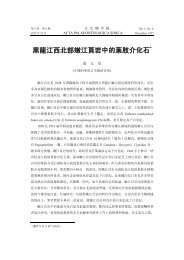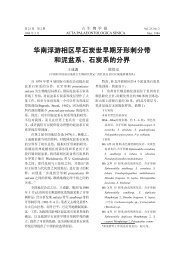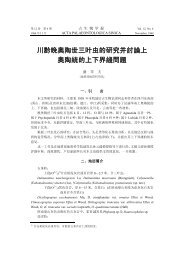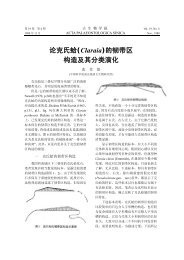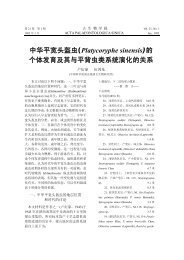古油节虫(Palaeolenus)在安徽凤阳的发現 - 中国科学院南京地质 ...
古油节虫(Palaeolenus)在安徽凤阳的发現 - 中国科学院南京地质 ...
古油节虫(Palaeolenus)在安徽凤阳的发現 - 中国科学院南京地质 ...
Create successful ePaper yourself
Turn your PDF publications into a flip-book with our unique Google optimized e-Paper software.
第 10 卷了 第 3 期 古 生 物 学 报 Vol. 10, No. 3<br />
1962 年 8 月 ACTA PALAEONTOLOGICA SINICA August, 1962<br />
<strong>古油节虫</strong>(<strong>Palaeolenus</strong>)<strong>在安徽凤阳的发現</strong><br />
朱 兆 玲<br />
(中国科学院地貭古生物研究所)<br />
本文所描述的<strong>古油节虫</strong>(<strong>Palaeolenus</strong>)的标本,系 1960 年中国科学院地貭古生物研<br />
究所和安徽省地貭局地貭研究所組成的皖中地层队在安徽凤阳发現的。化石产于下寒<br />
武統猴家山組的頂部,含化石地层出露情况如下:<br />
凤阳林場至螞蚁山剖面:<br />
上复地层:下寒武統饅头組<br />
猴家山組:<br />
————整 合————<br />
9.灰色、暗灰色块状灰岩,含矽貭及少量燧石結核,<br />
产:<strong>Palaeolenus</strong> fengyangensis Chu(新种)<br />
Redlichia sp. 1.97 米<br />
8.粉紅色、赭色厚层矽貭灰岩,底部含大块破碎燧石团块 3.14 米<br />
7.紫紅色薄层至中厚层泥貭灰岩,頂部含少量灰貭小砾石,向下漸变为赭色薄层含貭<br />
及泥貭灰岩,中部为粉紅色矽貭頁岩,偶夹中厚层至厚层泥貭灰岩 38.80 米<br />
6.浅紫紅色矽貭頁岩,偶夹燧石条带与結核 6.90 米<br />
5.上部为紫紅色矽貭頁岩,呈板状,下部为粉紅色矽貭灰岩,矽貭頁岩,具燧石<br />
条带或燧石結核 7.98 米<br />
4.粉紅色矽貭灰岩,偶含角砾状灰岩,砾石半稜角或稜角状 3.10 米<br />
3.淡紫色薄层至中厚层矽貭灰岩,淡紫紅色矽貭頁岩,偶夹黄綠色、紫紅色頁岩,<br />
下部泥貭成分較多 6.80 米<br />
2.淡紫灰色頁岩 3.63 米<br />
1.灰白色、玫瑰紫色矽貭灰岩,含白色燧石条带与自色灰貭小鲕粒(上都有一段<br />
掩盖) 7.60 米<br />
---------假整合--------<br />
下伏地层:上震旦統<br />
猴家山組一名系徐嘉炜于 1958 年創立的,命名地点在安徽凤台猴家山,它代表下<br />
寒武統饅头組以下和上震旦統假整合面以上的一段地层,其岩性主要为粉灰色、砖紅<br />
色、灰色矽貭灰岩,时夹紫色砂貭頁岩,矽貭頁岩,灰岩多含黑色燧石結核,下部有<br />
时有角砾岩层(0—100 米)和其他岩层的出現。因为沒有发現任何化石,猴家山組的时<br />
代,当时不能确定。凤阳地区所出露的寒武紀地层是淮南的东延部分,与淮南凤台完<br />
全可以对比,产<strong>古油节虫</strong>的岩层,属于猴家山組的頂部。<br />
<strong>古油节虫</strong>一属在国外曾发現于苏联西伯利亚(薩拉伊尔褶皺带)下寒武統勒拿組<br />
(Лена)的上部布拉吉諾段(Брагино)及西班牙下寒武統第二层內(自下而上,該区下寒武
3 期 朱兆玲:<strong>古油节虫</strong>(<strong>Palaeolenus</strong>)在安徽凤阳的发现 387<br />
統共分 5 层)。在国內产于云南东部的滄浪鋪组,貴州北部的明心寺組,湖北西部的天<br />
河板組和石牌組,天山东部的西大山羣以及秦岭东部下寒武統內;而在华北、东北等<br />
地很少发現,除凤阳地区外,在山东沂河流域(北京地貭学院采集,項礼文同志鉴定)<br />
及辽宁田师付附近碱場(东北地貭学院所存标本,张文堂先生鉴定)均有<strong>古油节虫</strong>的发<br />
現,这些发現說明在这些地区內,下寒武統饅头組以下尚有相当于云南东部滄浪鋪組<br />
或部分滄浪鋪組的存在,同时也明确了淮南凤阳一带的猴家山組的时代应属早寒武世<br />
中期,可以和云南滄浪鋪組(或部分滄浪鋪组)进行对比(見对比表)。<br />
由于<strong>古油节虫</strong>在华北及东北等地区的发現,証实了早寒武世中期的海浸曾到达秦<br />
岭以北某些地区內,因此,值得今后注意的是除了目前巳知的几个地点外,在华北、<br />
东北等地区內广泛分布的下寒武統饅头組以下是否还有相当于滄浪鋪組的存在,或者<br />
含这个属的地层仅限于部分地区,尚待进一步工作証实。<br />
本文承卢衍豪教授审閱及詳細修改了文稿、斯行健教授細心修改英文原稿,穆思<br />
之教授及张文堂先生提出宝貴意見及修正文稿,笔者謹致以衷心的感謝。此外,庞茂<br />
芳同志及周思三同志摄制标本照片,张务聪先生繪图,一并附此志謝。<br />
椭圆头虫超科 Ellipsocephalacea Matthew,1887<br />
椭圓头虫科 Ellipsocephalidae Matthew,1887<br />
<strong>古油节虫</strong>属 <strong>Palaeolenus</strong> Mansuy,1912<br />
凤阳<strong>古油节虫</strong> <strong>Palaeolenus</strong> fengyangensis Chu(新种)<br />
(图版 I 图 1—7;插图 1)<br />
特征:头鞍向前扩展。第二和第三对头鞍沟略向前傾斜。固定頰比較寬。頸环上<br />
具有一中疣。
388 古 生 物 学 报 10 卷<br />
材料:标本为 5 个头盖,采自安徽中部下寒武統猴家山組。由于标本破碎,难以<br />
准确測量。<br />
描述:头盖凸起,較寬,近似方形;头鞍強烈凸起,逐漸向前扩展,前端寬圆,<br />
其长度約少于底部寬的 2 倍,具有斗对头鞍沟:第一对(最后一对)最长,两侧深,向<br />
浅并向后斜伸,横过头鞍;第二內变对較短,仅<br />
有头鞍寬度的 1/3,略向前斜伸,两側較深;第<br />
三对与第二对平行,較浅;第四对短而微弱,仅<br />
隐約可見。頸沟直,深而狹;頸环凸起,中部寬,<br />
向两側变狹,靠近后緣有一尖而小的中疣。內边<br />
緣平坦或略凸起,外边緣強烈凸起,前缘向前拱<br />
曲,其长度与內边緣相似,边緣沟較浅。眼脊与<br />
眼叶連續伸延,从第三与第四对头鞍沟中間相对的位置起,向外并略向后伸展;眼叶<br />
約为头鞍长度的一半。固定頰較寬,近似矩形,平緩凸起,其寬度略窄于头鞍底部的<br />
寬度。后边緣凸起,內部狹,向外逐漸变寬;后边緣沟寬而深。面线前支自眼叶前端<br />
向前微略扩张伸延,切割前緣呈一圓弧形;后支短,从眼叶后端作寬而突出的曲綫伸<br />
展,向后斜伸切于后边緣。<br />
讨論:这个新种的头鞍外形与云南东部滄浪鋪組及貴州北部明心寺組所产的<br />
Palaeo- lenus deprati Mansuy (Mansuy 1912,30 頁,图版 4,图 3a—b;卢衍豪,1941,<br />
84 頁,图版 1,图 12a—c)的头鞍形状非常相似,其不同之点为本种頸环上出現小疣,<br />
固定頰比較寬,第二和第三对头鞍沟略向前傾斜。此种与云南东部滄浪鋪組所产的<br />
<strong>Palaeolenus</strong> tingi Lu(卢衍豪,1941,83 頁,图版 1,图 15a—b)一样,在頸环上也出現<br />
一中疣;但两者不同的是,P. tingi 的头鞍呈长矩形,固定頰較狹。P. fengyangensis 与<br />
P. douvillei Mansuy(Mansuy,1912,29 頁,图版 3,图 6a—d,图版 4,图 1a—d;卢<br />
衍豪,1941,83 頁,图版 1,图 14)和 P. lantenoisi Mansuy (Mansuy,1912,29 頁,图<br />
版 4,图 2a—c;卢衍豪,1941,84 頁,图版 1,图 13a—c)同样地具有較寬的固定頰,<br />
但是 P. douvillei 的头鞍两側平行,P. lantenoisi 的头鞍在中部略有收縮,并且这两个<br />
种的頸环上都沒有中疣。<br />
P. fengyangensis 与苏联西伯利亚地台、外貝加尔附近及庫茲湼次克的阿拉套等地<br />
中寒武統底部所产的 Schistocephalus Tchemysheva 一属有許多特征相同,其相同之点<br />
为头鞍的外形,具有四对連續或不連續的头鞍沟,連續伸延的眼脊与眼叶以及大小相<br />
似的后側翼。Schistocephalus 与 <strong>Palaeolenus</strong> 的区别是个体較大,內边緣較狹,面綫前<br />
支較向外扩张,背壳表面具疣点。根据以上所述,<strong>Palaeolenus</strong> 和 Schistocephalus 可能<br />
有血緣关系,同属于一个演化系統。早寒武世中期的 <strong>Palaeolenus</strong> 可能是中寒武世早期<br />
Schistocephalus 的祖先。<br />
参 考 文 献<br />
[1] 尹贊勳、諶义睿、秦鼐,1945: 湄潭县之寒武紀地层。地貭論評,10 卷,5—6 期。<br />
[2] 卢衍豪(Lu Yen.hao),1941:Lower Cambrian stratigraphy and trilobite fauna of Kunming, Yunnan,<br />
Bull.Geol. Soc. China, vol.21, no.1.<br />
[3] ——,1957:中国标准化石。无脊椎动物第三分册(三叶虫部分)。<br />
[4] ——,1961:滇东早寒武世新三叶虫。古生物学报,9 卷 4 期。<br />
[5] 卢衍豪、董南庭,1953:山东寒武紀标准剖面新观察。地貭学报,32 卷 3 期。
3 期 朱兆玲:<strong>古油节虫</strong>(<strong>Palaeolenus</strong>)在安徽凤阳的发现 389<br />
[6] 叶戈洛娃,Л.И.,項礼文,1958:秦岭东部寒武紀三叶虫新发現。古生物学报,6 卷 4 期。<br />
[7] 沃罗格金,А.Г., 1957:苏联的寒武系。古生物学报 5 卷 2 期。<br />
[8] 张文堂等,1957:湖北峡东寒武紀及奧陶紀地层。科学通报,5 期。<br />
[9] 张日东等,1959:新疆天山南麓古生代地层。古生物研究所集刊,2 号。<br />
[10] 徐嘉炜,1958:华北南部寒武系下限問题。地貭論評,18 卷 1 期。<br />
[11] 潘 江、薛志照,1959:淮南、冀东震旦、寒武系分界問題的商榷。地貭論評,19 卷 2 期。<br />
[12] Черньшева, Н. Е.,1956: Новые роды трилобитов, Материалы по Палеонтологии. Тр.<br />
ВСЕГЕИ,нов. сер., вып.12, стр.147—150.<br />
[13] Chang, W. Y., (张文佑) 1937: Cambrian trilobite of Anhui central China. Contr. Nat. Res. Inst. Geol.<br />
Acad. Sin., no.6.<br />
[14] Lotze, F.,1958: Zur stratigraphie des Spanischen Kambriums. Geol., Jab.7, Heft 3—6.<br />
[15] Mansuy, H.,1912: Etude Geologique du Yunnan Oriental. Mem. Serv. Geol. l'Indochine, vol.1,<br />
fasc,2, pt.2., pt. 2.
390 古 生 物 学 报 10 卷<br />
ON THE OCCURRENCE OF PALAEOLENUS IN<br />
FENGYANG, ANHWEI<br />
Chu Chao-Ling<br />
(Institute of Geology and Palaeontology, Academia Sinica)<br />
(Summary)<br />
The specimens described here as a new species of <strong>Palaeolenus</strong>, P. fengyangensis<br />
Chu (sp. nov.), were collected by the writer and her co-workers from the upper part of the<br />
Houchiashan Formation of Fengyang, central Anhwei in 1960.<br />
The term Houchiashan Formation was proposed by Hsu Chia-wei in 1958 to include<br />
a sequence of rocks disconformably underlain by the Upper Sinian Szutingshan Formation<br />
and conformably overlain by the Manto Formation of late Lower Cambrian age. It is<br />
composed of reddish grey and grey siliceous limestones intercalated with sandy shales,<br />
occasionally with breccia (0-100 meters) at the base. The total thickness is about 80-140<br />
meters.<br />
The genus <strong>Palaeolenus</strong> is widely distributed in the Eurasian continent. It has been<br />
found in Yunnan, Kueichow, Hupei, Honan and eastern Tienshan of China and also in some<br />
localities of Siberia and Spain. It is a leading fossil of the middle part of the Lower<br />
Cambrian in South and West China, i.e. the Tsanglangpu Formation of E. Yunnan, the<br />
Mingsinsze Formation of N. Kueichow, the Tienhopan Formation of W. Hupei, the<br />
<strong>Palaeolenus</strong> bed of W. Honan and the Sitashan Formation of eastern Tienshan. The finding<br />
of this genus in the Houchiashan Formation of central Anhui may be thus taken as an<br />
evidence for correlating all these beds.<br />
Besides <strong>Palaeolenus</strong> fengyangensis described here, the genus is represented in<br />
China by the following species: P. douvillei Mansuy, P. lantenoisi Mansuy, P. deprati<br />
Mansuy, P. tingi Lu and P. sinkiangensis Lu.<br />
Superfamily Ellipsocephalacea Matthew,1887<br />
Family Ellipsocephalidae Matthew,1887<br />
Genus <strong>Palaeolenus</strong> Mansuy,1912<br />
<strong>Palaeolenus</strong> fengyangensls Chu (sp. nov.)<br />
(PI.1, figs.1-7; Text-fig.1)<br />
Diagnosis: Glabella expanded forward. Second and third lateral glabellar furrows<br />
directed slightly forward. Fixed cheek relatively broad. Occipital ring with a median Erode.<br />
Material: Five cranidia from the <strong>Palaeolenus</strong> fengyangensis zone of Houchiashan<br />
Formation, central Anhwei.<br />
On account of the fragmentary preservation of all the specimens, the measurements<br />
cannot be given.<br />
Description: Cranidium convex, broader than long, subquadrate in outline. Glabella<br />
strongly convex from side to side and in front, gradually exi0anding forward and broadly<br />
rounded in front, with a length slightly less than twice the basal width. Four pairs of lateral<br />
glabellar furrows present: posterior pair longest, deep on sides, shallowing inward and
3 期 朱兆玲:<strong>古油节虫</strong>(<strong>Palaeolenus</strong>)在安徽凤阳的发现 391<br />
extending obliquely backward from the dorsal furrows to meet with cach other at the middle<br />
of the glabella; second ones shorter, about one-third the width of the glabella, running<br />
slightly oblique forward; third pair parallel to the second, but much shallower; fourth pair<br />
short and very weak, discernible only under oblique light. Occipital furrow straight, deep<br />
and narrow. Occipital ring convex, broad in middle, narrowing laterally, provided with a<br />
small median node on posterior margin. Brim depressed, nearly flat or slightly convex.<br />
Frontal border strongly convex, arched forward, as long (sag.) as the brim, and separated<br />
from the latter by a very shallow marginal furrow. Ocular ridge and palpebral lobe<br />
continuous, prominent, extending from the dorsal furrow opposite the midway between<br />
the third and fourth lateral glabellar furrows directly outward and slightly backward;<br />
palpebral lobe about one-half the length of the glabella. Fixed cheek subrectangular in<br />
outline, gently convex, slightly narrower than the basal width of glabella. Posterior border<br />
narrow in inner part, widening laterally; posterior marginal furrow broad and deep.<br />
Anterior sections of facial sutures very slightly divergent from the palpebral lobes<br />
forward cutting the frontal border in a rounded angle; posterior gections short, running in a<br />
borad convex curve from the posterior end of the palpebral lobes to the posterior margin of<br />
the cranidium.<br />
Remarks: The new species is closely allied to <strong>Palaeolenus</strong> deprati Mansuy<br />
(Mansuy,1912, p.30, pl.4, figs.3a-b; Lu,1941, p.84, pl.1, figs.12a-c.) from the Tsanglangpu<br />
Formation of E. Yunnan and the Mingsinszu Formation of N. Kueichow in the shape of<br />
glabella, but differs from the latter in the presence of an occipital node, in the comparatively<br />
broader fixed cheek and in the second and third lateral glabellar furrows which extend<br />
slightly forward instead of transverse in deprati. <strong>Palaeolenus</strong> tingi Lu (Lu,1941, p.83, pl.1,<br />
figs.15a-b.) from the Tsanglangpu Formation of E. Yunnan agrees with the present species<br />
in the presencg of an occipital node, but the Yunnanese species is easily distinguished by the<br />
elongated rectangular glabella and by the narrow fixed cheek. The relative width of the<br />
fixed cheek of P. fengyangensis is comparable with those of P. douvillei Mansuy<br />
(Mansuy,1912, p.29, pl.3, figs.6a-d, pl.4, figs.1a-d; Lu,1941, p.83, pl.1, fig.14.) and P.<br />
lantenoisi Mansuy (Mansuy,1912, p.29, pl.4, figs.2a-e; Lu,1941, p.84, pl.1, figs.13a-c.),<br />
however, P. douvillei has a parallelsided glabella and the glabella of P. lantenoisi is<br />
contracted at the middle. Furthermore, the median node is not present in the occipital rings<br />
of the latter two species.<br />
<strong>Palaeolenus</strong> fengyangensis resembles Schistocephalus Tchernysheva (Tchernysheva<br />
1956) of the family Paradoxididae from the early Middle Cambrian of Siberia and<br />
Kuznetsk in general outline of the glabella, in the presence of four pairs of glabellar furrows,<br />
in the size of ocular ridge and palpebral lobe, and in the shape of the posterolateral limb.<br />
Schistocephalus differs from P. fengyangensis in some minor features: e.g. the larger<br />
cranidium, the comparatively narrow brim, the strongly divergent anterior facial sutures and<br />
the granulated test. It appears possible that <strong>Palaeolenus</strong> and Schistocephalus are genetically<br />
related. They may actually belong to the same evolutionary trends. <strong>Palaeolenus</strong> may be<br />
regarded as an ancestral form of Schistocephalus.
392 古 生 物 学 报 10 卷<br />
图 版 說 明<br />
本文內所描述的标本均保存在中国科学院地貭古生物研究所<br />
图 版 I<br />
图 1—7. <strong>Palaeolenus</strong>.fengyangensis Chu(新种)<br />
1.头盖,×6,登記号:13666.<br />
2.同上头盖,×10。<br />
3.头盖,×4,登記号:13667。<br />
4.同上头盖,×10。<br />
5.头盖,×10,登記号:13668。<br />
6. 头盖,×10,登記号:13669。<br />
7.头盖,×6,登记号:13670。<br />
Explanation of plate<br />
The specimens described in this paper are all kept in the Institute of Geology and Palaeontology,<br />
Academia Sinica.<br />
Plate 1<br />
Figs.1—7. <strong>Palaeolenus</strong> fengyangensis Chu (sp. nov.)<br />
1. Cranidium, ×6, Cat. No.13666.<br />
2. The Same, ×10.<br />
3. Cranidium, ×4, Cat. No.13667.<br />
4. The same, ×10.<br />
5. Cranidium, ×10, Cat. No.13668.<br />
6. Cranidium, ×10, Cat. No.13669.<br />
7. Cranidium, ×6, Cat. No.13670.




